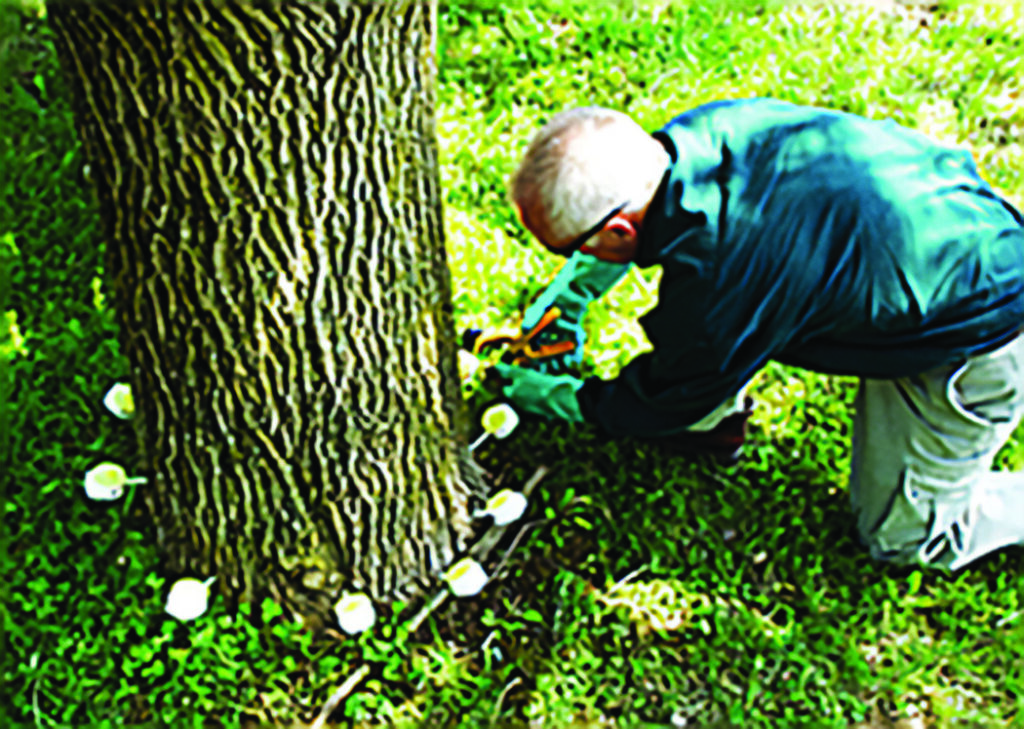
Inoculation can save ash trees from the EAB, but the process must be repeated every two or three years.
Nancy Edmonds Hanson
Moorhead’s war against the invading emerald ash borer is gaining ground. But victory, says city forester Trent Wise, is far from certain.
“I don’t know who’s winning,” he says. “But I do think we have a good plan, and we’re holding our own.”
The enemy is easy for civilians to overlook – a shiny, bright green beetle just a little larger than a grain of rice. But don’t underestimate it based on its size. Since 2002, when the first wood-boring beetles arrived in Michigan aboard freighters from Asia, they have steadily claimed ground. They reached St. Paul in 2009. By now, 35 states, from the East Coast to as far west as Colorado have identified EAB (emerald ash borer) infestations within their borders.
“There’s been a slower build-up in Minnesota than in other areas,” he reports hopefully. “That may be due to a combination of public awareness and preventative steps that Moorhead and other cities are engaged in.”
The first EABs were spotted in Moorhead last March along Fourth Avenue South near Moorhead High School. That area became the first battlefront. Wise reports his crews removed 300 trees throughout an eight- to ten-block radius of Ground Zero on public property, including boulevards, parks and rights-of-way. “We ground the stumps to a depth of 12 to 18 inches and replanted a large majority of them last fall,” he says.
Younger trees – those with diameters of less than 10 inches – were targeted for removal. Larger trees that showed no damage were treated with emamectin benzoate, considered the most effective weapon against the invaders. The chemical is injected into the tree at its base and travels upward through the phloem. The city has invested almost $25,000 in chemical treatments and the equipment to inject the trees, a process that takes about 20 minutes … but must be repeated every two to three years. Much of the cost is being covered by a grant from the Minnesota Department of Natural Resources
Arborists typically identify the telltale tracks of the insidious invaders not by spotting the tiny insects themselves, but by watching for unusual woodpecker damage. “The birds feast on the larvae beneath the bark,” Wise explains. “When you see excessive damage toward the top of the tree, you can assume the woodpeckers have found them.”
Attacks start toward the top, he adds, because the larvae need to draw nutrition from the phloem tissue that draws nutrition from the roots throughout the tree. Because the S-shaped “galleries” they form cut off that flow for the tree itself, it dies off from the top down.
While it first met the enemy face-to-face last summer, the forestry department had been preparing for the inevitable battles for 15 years. One defensive measure has been to reduce the number of ash trees in the city. That’s been a mammoth undertaking. An estimated quarter of the 27,000 trees on city-owned land are ash. Much of the rest of the so-called “urban forest” is divided among maple, linden and elm.
In parts of the city, the number of elms has been greatly reduced by Dutch elm disease. It remains a threat even now, 40 years after the epidemic that destroyed countless stately specimens. The forestry crew continues to remove 60 to 100 from the city’s boulevards every year, plus another 100 along the river corridor. Unfortunately, in preceding years, many of those lost elms were replaced with sturdy, cheap ash trees.
The forestry crew has been systematically reducing the proportion of ash trees in the civic mix by 300 per year, aiming for a goal of no more than 5,000 left standing. The missing trees are being replaced with some varieties that have an unfamiliar sound, says Wise, including Kentucky coffee tree, hackberry, catalpa, burr and Heritage oak, black walnut, and several varieties developed by NDSU ,including Northern Acclaim honey locust (male trees only), Prairie Horizon alder and Northern Advance American planetree, a type of sycamore.
Over the next three years, Wise says, his crews plan to inoculate 1,700 ash trees per year, about one-third of the remaining population. When all have been vaccinated, they will start again; the process must be repeated to extend the protection.
That’s what the future looks like for trees on public grounds. But what about the countless ash trees that shade private yards across the city?
Their fate is in homeowners’ hands. Wise’s department has been working hard to get word out about coping with the tiny enemy. Insight and advice are available on the city’s website; go to www.cityofmoorhead.com and search for “emerald ash borer prevention.” He advises that damaged or unwanted ash trees be removed to prevent future problems that are probably inevitable. Healthy trees can be treated by drenching the surrounding soil with neonicotinoids like dinotefuran or imidacloprid. Preventive treatment of large, mature trees, however, may best be tackled by a professional tree company using the injection method.
“Each situation may dictate a different approach,” he suggests. “I can say what the city is doing and why we’re doing it, but it’s up to homeowners to decide what’s best for their trees.”
Treating 1,700 trees is a big order, especially since it’s being done along with all the regular trimming and removal on the arborists’ agenda. Wise, though, is optimistic. “As long as the weather cooperates this summer, I’m confident we’ll accomplish what we want to get done,” he emphasizes. But that’s always a maybe: “No matter how well we plan, we can never control Mother Nature.”


